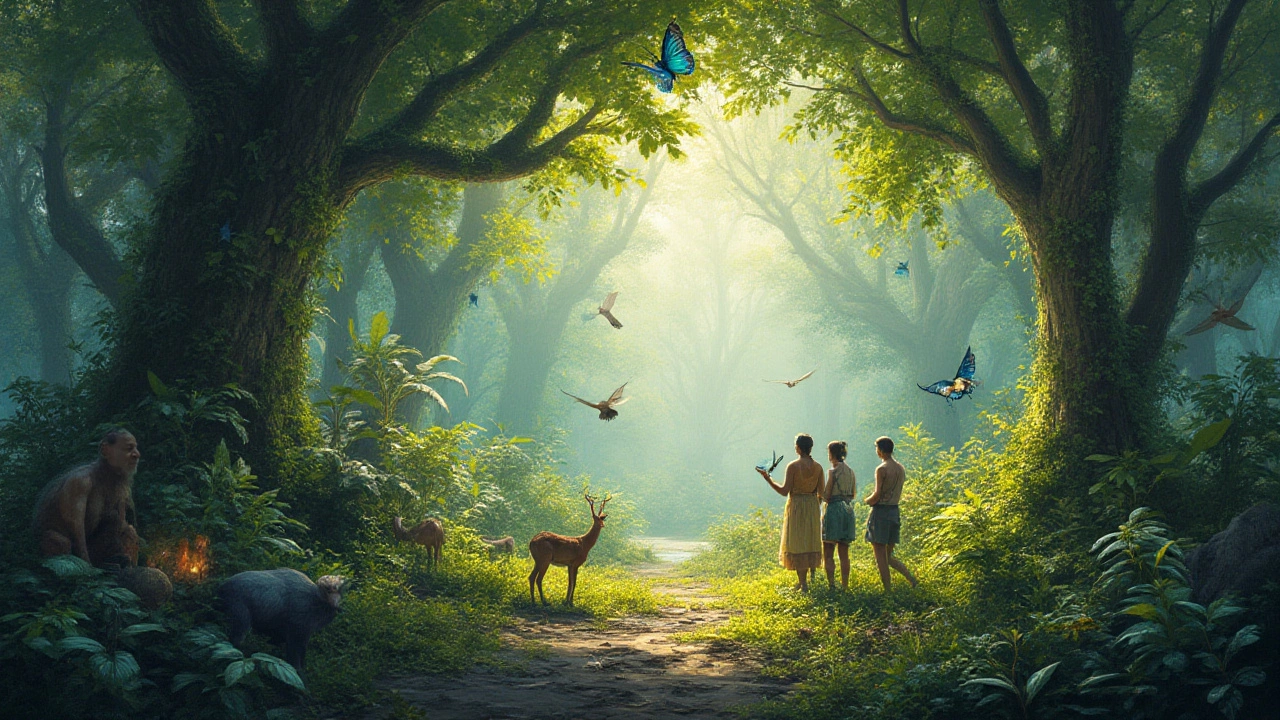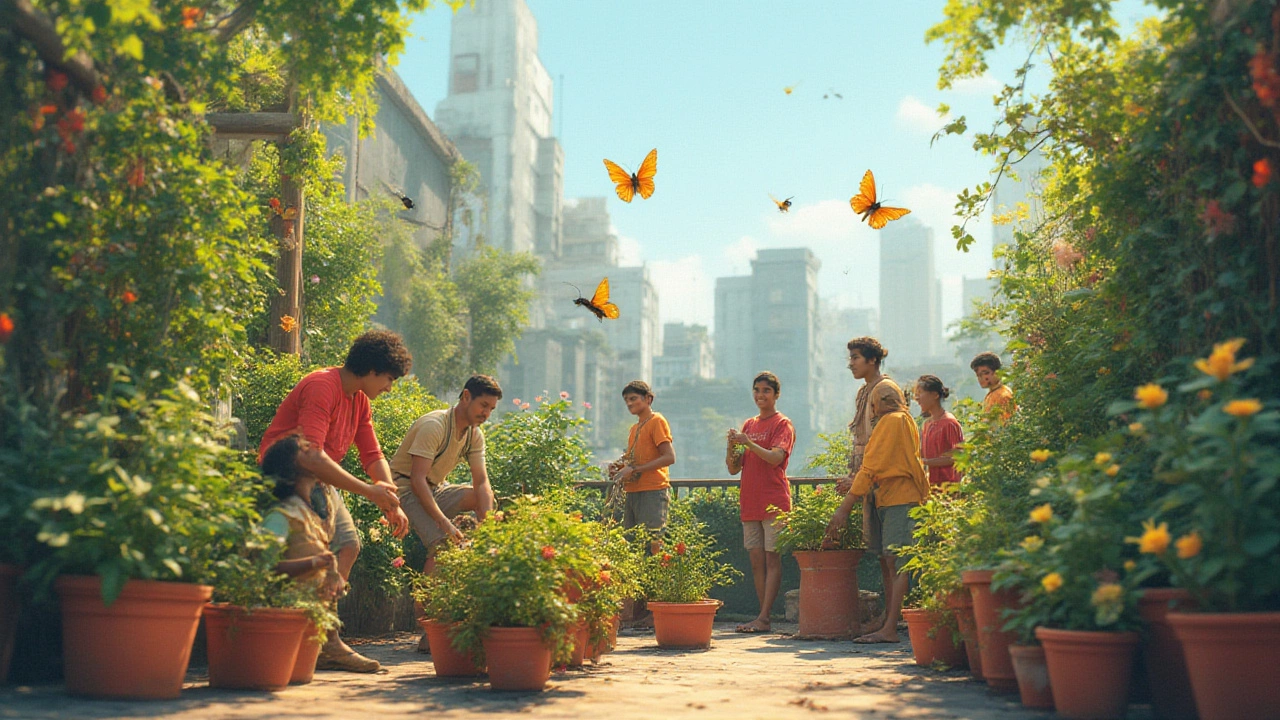
- Created by: Lydia Carmichael
- Completed on: 30 Jul 2025
- Categories: Environment
Imagine diving under a coral reef or hiking through a lush forest. Each spot is bursting with life, but not in a random way. All those birds, bugs, plants, and tiny bacteria aren’t just sharing space—they’re organizing themselves, reacting to their environment, and playing unique roles. This isn’t just nature’s chaos. It’s called a community, and it’s what makes an ecosystem tick. These groups aren’t just about who eats who. Communities shape everything from weathering rocks into soil to purifying air. Let’s look at how communities show up in ecosystems, how they’re different from each other, and what makes each kind essential for life.
What Defines a Community in an Ecosystem?
So, what exactly does ‘community’ mean in the wild world of ecosystems? Think of it as all the living things—plants, animals, fungi, and even microscopic critters—that call the same place home and interact with each other. If you step into a pond, that pond might hold frogs, insects, algae, and fish, all forming a living network. Every community is powered by relationships: who’s eating, sheltering, or teaming up with whom. Unlike a population (one species), a community mixes species together. These interactions can get weird and complicated—sometimes it’s all-out war, sometimes surprising cooperation rules. For instance, bees feeding off flowers and spreading pollen, or wolves hunting deer and shaping forests even without eating every deer. The classic definition (going back to botanist F.E. Clements in the early 1900s) describes a community as an association of populations occupying a certain environmental area, while other scientists argue for a more loose-knit, constantly-changing network.
What keeps these groups together? Location, for one. A community is anchored in a spot: a desert dune, a grassland field, or even your backyard compost pile. Shared needs tie them together—everyone must deal with sunlight, water, soil, and predators. But what really glues a community are the relationships. There are the obvious ones (predator and prey), but also sneaky ones—like fungi that weave into tree roots or bacteria that let cows digest grass. Some communities, like the microbial mats in Yellowstone hot springs, thrive in boiling water. Others, like the cold-loving creatures under Antarctic ice, barely see the sun at all. No matter where they are, these living networks are about more than just survival. They’re about how living things shape each other, for better or worse.
Turns out, the way a community is put together depends on who lives there, how many there are, and how they interact. Scientists look at species composition (who’s present), abundance (how many of each), and diversity (how mixed up it is). Flip over a rock and you might see ten kinds of bugs, but maybe only one is everywhere. Some communities have a single superstar (like redwoods towering in a forest), others are an even mix. Even the newcomer or rarely-seen plants and animals matter—some have outsized impacts, like a lone wolf scaring deer from overgrazing, literally changing how forests grow. So a community is much more than a checklist: it’s a story about relationships in a place.
Major Types of Communities in an Ecosystem
Not all communities are built the same way. Ecologists generally split them into two big types: major (or biomes) and minor (or micro-communities). Major communities, sometimes called ‘macro-communities,’ are huge—think forests, grasslands, or ocean reefs. They usually cover big geographic areas and last for centuries. Each is shaped by climate, available nutrients, and often a ‘keystone’ species that holds the place together (like elephants in savannahs stomping down trees, or beavers building dams). Major communities are the big, world-defining canvases we read about—rainforests, tundras, deserts, and the open sea. Each has its signature look, feel, and cast of characters. Micro-communities, on the other hand, are tiny patches inside those bigger biomes. Think moss on a tree trunk, an ant colony, or a puddle teeming with life. The fun part? The rules that work for big communities do not always work for the tiny ones.
Communities can also get grouped by what kind of life dominates and where. Terrestrial communities form on land, full of visible plants and animals, while aquatic communities—lakes, rivers, oceans—deal with water currents, buoyancy, and a very different set of survival tricks. Water-based communities might have plankton as the main energy source, while land communities depend more on green plants. Here’s where it gets interesting: Some communities pop up almost overnight (like wildflowers after a fire), while others develop over hundreds of years as climates shift. And then there are special edge-communities, called 'ecotones', where two biomes meet—think wetlands between forests and lakes—blending species from both sides and often bursting with even more life diversity.
To really grasp the diversity, check out the table below. It lists some well-known community types and what makes each unique:
| Community Type | Main Example | Main Species | Key Features |
|---|---|---|---|
| Forest | Amazon Rainforest | Trees (Mahogany), monkeys, jaguars | Multi-layered, high rainfall, high species diversity |
| Grassland | Great Plains | Grasses, bison, prairie dogs | Fires shape growth, few trees, rich soils |
| Aquatic | Coral Reef | Corals, colorful fish, crustaceans | High productivity, complex food webs |
| Desert | Sahara | Cacti, snakes, scorpions | Dry, sparse vegetation, adapted species |
| Tundra | Arctic Tundra | Mosses, arctic foxes, caribou | Cold, permafrost, short growing season |
| Freshwater | Pond | Algae, frogs, snails, fish | Seasonal variations, life cycles tied to water |
So, the type of community depends on where it lives, who’s there, and what tricks they use to survive. Want to spot different communities? Notice the plant cover, animal sounds, smells, and, if you’re feeling brave, peek under rocks or logs. The types are different everywhere, shaped by millions of years of shifting climates, wandering animals, and changing landscapes.

How Communities Work: Roles and Relationships
Every member in a community, big or small, has a job. Scientists call these jobs ‘niches.’ It’s not just what you eat, but when you’re awake, how you avoid predators, and what you do to survive. The more varied the roles, the stronger the community. Communities sort themselves into layers, both literally (think canopy and forest floor) and by what creatures do. The classic three layers are producers (plants, algae), consumers (herbivores, carnivores, omnivores), and decomposers (bacteria, fungi, worms). Each group keeps the next one in balance. If you ever hear the phrase ‘trophic level’, that’s just ecologists’ way of saying who eats what in the food chain. A types of communities wheel keeps spinning as energy and nutrients cycle from sunlight to plant to animal to decomposer, back to the earth, and up again.
Some relationships in communities are obvious—like lions hunting zebras. But the ones you can’t see might be even more important. Microbes help roots suck up nutrients from dirt. Birds spread seeds after lunch. There’s competition, too—giraffes and elephants battling for the best trees, or weeds pushing out garden veggies. But nature isn’t just about fighting. Mutualism—helpful partnerships—are everywhere, like clownfish and sea anemones, or cleaner shrimp picking gunk off fish. Sometimes competing animals carve out different hours or diets, so nobody loses. This balance is fragile. If one part tips too far—say, too many deer and not enough wolves—other species get squeezed out.
Communities also have a built-in resilience. When a storm, fire, or pest hits, some members will die or leave, but most communities bounce back or rebuild, often stronger than before. Sometimes a community gets pushed too far and shifts entirely; that’s called 'succession.' Forests regrow after fires, grasslands take over abandoned fields, and coral reefs try to recover after bleaching. The rate of recovery depends on diversity. More roles, more kinds of life, means better odds of bouncing back after trouble. That’s why scientists worry when diverse communities shrink—it’s not just a loss of beauty but of the ecosystem’s ability to handle surprises.
Special and Urban Communities: Adapting to Human Influence
Not every community is untouched wilderness. City parks, rooftop gardens, and landfill marshes are their own unique communities. Urban environments mash up native species with newcomers in ways that sometimes create brand-new networks. In cities like London or Los Angeles, you might spot parakeets, squirrels, foxes, and hundreds of bug species adapting alongside humans. These are urban ecosystems, where the lines between natural and artificial get blurry and the rules of nature bend. Urban communities tend to be less diverse but sometimes show amazing resilience—look at how trees can grow through concrete cracks or how pollinators use tiny city gardens as pit stops.
There are also ‘artificial’ communities humans create for farming, like rice paddies, orchards, or aquarium tanks. While these aren't as diverse as wild ones, they still have community structure—pests, crops, helpful bugs, soil microbes. And don’t forget restored or managed communities. Across Europe and North America, people are rebuilding wetlands, forests, and prairies. These projects tip the scales back toward natural patterns: reintroducing beavers to rebuild rivers, planting native grass species, or adding wildflower strips along farm fields to encourage pollinators.
Some special communities are only found in extreme or oddball places. Hydrothermal vent communities, deep in the oceans, support giant tube worms, clams, and bacteria living on chemicals, not sunlight—discovered only in the late 1970s. Then there are cave communities, salt flats, or acidic bogs that support rare and highly specialized species. Every time scientists peer somewhere new, they seem to find a community perfectly shaped for that place, proving that life finds a way almost everywhere.

Why Ecosystem Communities Matter and Tips for Supporting Them
Why should we care what’s living in a patch of woods or a swamp? It turns out, communities don’t just make places interesting—they’re essential to everything we need. Healthy communities clean water, make air breathable, keep soil rich, and even reduce disease risks. Lose one key part (like too many insecticides wiping out bees), and the whole system can wobble. In 2020, a research group at Stanford showed that forests with mixed tree species store more carbon than tree farms with just one kind. Another study found that urban green spaces—even small ones—boost pollinator numbers and reduce city heat, improving people’s mental health. Each of these benefits comes from a diverse, interacting community.
So if you want to help, here are some simple tips that anyone can act on, no matter where you live:
- Plant native flowers and shrubs—they give local pollinators and birds a fighting chance.
- Don’t use pesticides unless absolutely necessary; even a few can knock out keystone insects or soil microbes.
- Leave some wild corners in your yard or community garden. Fallen logs, leaf piles, and old stumps are top real estate for tons of tiny creatures.
- Look for community science projects (like local bird counts or butterfly monitoring)—the data helps scientists track changes and protect rare or threatened communities.
- Support restoration efforts: if you have a pocket of land, think about planting trees, wildflowers, or letting a section go 'wilder' for a bit.
- If you have kids or friends who like exploring, teach them to observe gently—roll logs back, photograph instead of collect, and leave those weird mushrooms alone unless you know they’re safe!
Talk to neighbors about what lives in your area. Swap plant seeds. Set up a little rain garden, or grab binoculars and try to spot who visits your local park at sunset. The more we understand and appreciate community diversity in every ecosystem, the more we’re able to protect all those invisible connections that keep the planet humming along.